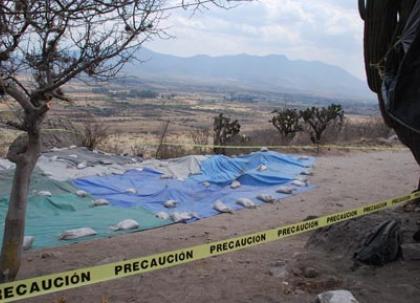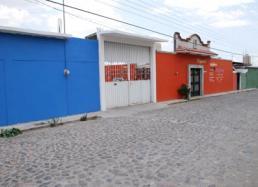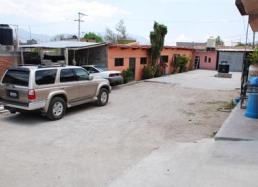6: Swine Flu
Over the past week, we have received numerous inquiries and expressions of concern from friends, family, colleagues, and even distant acquaintances regarding the outbreak of swine flu here in Mexico. First off, let me say how deeply appreciative we are of these sentiments. I have written everyone who wrote, personally assuring each person that all members of our crew (American and Mexican) are doing fine.
Nevertheless, I also wish to offer thoughts on what happened and what it was like to continue to implement an archaeological field project in the face of a modest brush with disease and an overabundance of anxiety.
When we began in the field late in March and early in April, a number of members of our Mexican crew had sniffles and coughs. Nothing seemed particularly serious or out of the ordinary, since January through April is the cold/flu season in Mexico. January and February tend to be the coolest months of the year in Oaxaca.
At the same time, January through April represents the heart of the dry season, a time when—before superhighways and non-agrarian sources of income—food (especially fresh foods) tended to be in shortest supply. In fact, many Mitleños attribute outbreaks of colds and flu to the changes in weather alone (quick transitions from warm to cold or from dry to wet) that are typical of March and April. Their view of disease is that the body is worn out by these rapid climatic swings and succumbs with illness.
By the second week of April, the sniffles, coughs, and runny noses were jumping from one crew member to the next, ultimately jumping to Linda and then (a few days after) me, before we even heard the words swine flu and Mexico in the same sentence.
If the truth be told, Linda mentioned during her outset that maybe she had more than a simple cold (la gripa), as her body ached a bit and she carried a splitting headache for a few days. Never did she (or I) miss a day in the field, although we did make concerted efforts to go to bed early and wash our hands regularly when feeling a bit ill.
By the time the vacation and travel weeks surrounding Easter (Semana Santa) passed, along with Obama’s visit, Rolando and I were about the last ones who were going to be infected on our archaeological team who were still sniffling and hacking.
And, then the news hit, first with the sad and shocking report that our colleague and curatorial collaborator on the Field’s Aztec Exhibition (Felipe Solis, the Director of the National Anthropology Museum of Mexico) had passed due to cardiac arrest associated with pneumonia. This news was so unexpected and devastating, since he seemed so healthy and strong in Chicago at the opening of the Aztec show in late October. This is a great loss.
And then within hours, came the global reports of a new strain of flu in Mexico, with a rumored epicenter and even an early death in Oaxaca. This flu was claimed to kill relatively healthy individuals with a death rate said at first to be above 5% of those infected (which would be incredibly high). My cold, which to this point had not seemed especially bad or unusual, immediately felt a little bit worse. But, at the same time, something regarding the global panic and the announced patterns just did not ring true.
Naturally, as Project Director, responsible for many and with new crew members expected in weeks, I started to research this epidemic in whatever ways that I could, late in the evening after fieldwork, checking notes, and answering email. I got on the computer and read on the virus, its spread, and the actions taken to combat it. As the infection passed, perhaps allowing my head to clear, I came to a perspective that is now shared by many. This particular strain of influenza, which likely had an early take-off point in Mexico, probably was being passed around for longer than was first announced.
Local reports claim that as early as February 2009 the flu was rampant in some local communities. But few of those afflicted went for medical treatment and no one was tested. So consequently, the initially reported death rates from this strain were way off base, far too high.
My guess (although entirely untested) is that Linda and I were two of the many who may have had swine flu before we knew what that was. But without tests and doctor visits, we aren't part of any count. After all, annually, influenza kills 36,000 people in the United States, but the percentage of those infected who die is much less than 1%. Now, it appears that this strain of swine flu is even less deadly (although, like any influenza virus, still nothing to trifle with).
Once the Mexican government sprang into action, schools and public venues were closed. For the first time in my memory, all archaeological sites in Mexico, including the Mitla ruins, were shut for about a week (see Photo #1 below.) Here, traffic and tourism are once again down, having just started to recover from the political unrest of two years ago. Our small project has pressed on, but our crew seems to be some of the few who are working right now in Mitla.
My own informal observations of sniffling, hacking, and coughing indicate that the worst of the infection has passed and, with the exception of closures, things are pretty much back to normal. Tomorrow is the day when many people in Mitla visit the shrine at the Fortress during an annual pilgrimage. From what we hear, the crowd will be down and, in line with local governmental actions to limit public gatherings, we have cancelled a planned trip on Sunday. At the same time, I do hope that the drop in tourism turns around quickly, as so much of Mitla’s and the Valley of Oaxaca’s economy depends on it.
Word of the Day: “swine flu,” which is translated here as influenza porcina.
More soon,
Gary





